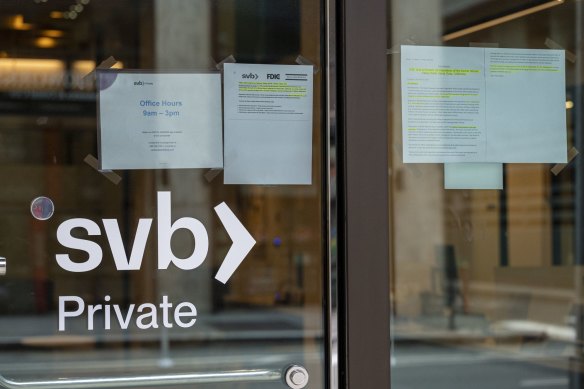Not only has money been cheap. Thanks to years of quantitative easing by the major central banks, there is also now a lot more of it. It is no surprise that many have become addicted.
This is the nub of the problem. Even if interest rates do not rise any further, the fallout from unwinding the long period of practically free money could drag on for years, and show through in many different ways.
The crisis headlined by the collapse of SVB is not even the first in what could be an extended series of unfortunate events.

The collapse of SVB kicked off a dramatic week for the global financial system. Credit:Bloomberg
The Bank of England, of course, had to intervene in the gilt market last autumn when the rise in interest rates threatened to blow up the “liability-driven investment” strategies that had been adopted by many British pensions funds.
The obvious question is where the problem might pop up next – and it is not difficult to think of candidates.
Starting big, how long can Italian government bonds be propped up by low interest rates in the eurozone and backstops provided by the European Central Bank? And what about Japan’s even higher mountain of debt, where the central bank is only just edging towards the exit from decades of ultra-loose monetary policy?
Loading
Outside the financial sector, significant parts of the British economy have yet to feel the full impact of last year’s interest rate increases and the tightening in financial conditions. For example, many smaller businesses are only just now coming off Covid support schemes and could soon find themselves paying much higher rates.
And closest to home, how about house prices? The rise in mortgage costs and increased economic uncertainty has already led to a sharp downturn in the housing market and in house building, both in Europe and America. But this could be the tip of the iceberg, as more homeowners come off their current low fixes and have to refinance. Bank of England analysis has suggested a sustained 1 per cent increase in real interest rates could lower the equilibrium level of house prices by as much as 20 per cent.
The bigger picture is therefore that we need to readjust to normal interest rates, and this will be painful. Weaker companies, and those with riskier business models, may struggle most, but they won’t be the only ones.
This poses two dilemmas for central banks. First, how far should they be willing to bail out failing institutions? If they do too little, the whole financial system might come crashing down. If they offer too much support, they may simply encourage more risky behaviour in future (the classic problem of “moral hazard”), or give the impression that the problems run even deeper now than anyone thought.
The chickens have come home to roost. We need to go cold turkey and stop banking on free money.
Second, on interest rates, how will central banks square their responsibility for financial stability with the commitment to monetary stability, that is, getting inflation back down again?
This is not an impossible choice. Central banks might argue that averting a financial crash would prevent inflation from falling too far. The authorities also have many different tools that they can use to achieve their different aims. But this is a difficult balancing act.
The European Central Bank (ECB) has already shown where its priorities lie. On Thursday it pressed ahead with another half-point increase in its key interest rates, despite the crisis engulfing European banks. Admittedly, the hurdle for the ECB to pause (or to raise by just a quarter point) was higher than for other central banks, because it had already committed to another half-point move.
It would therefore be wrong to read too much into this move ahead of the Bank of England’s own decision on British interest rates next week. Our Monetary Policy Committee takes each meeting as it comes (rightly, in my view), which gives them more flexibility to respond to new events.
Loading
There were also already some pretty good reasons to pause, including signs that pipeline cost pressures are easing and that wage inflation has peaked. So at most I would expect a quarter-point hike next Thursday, and personally would vote for “no change”.
Nonetheless, it would be wrong to rely on central banks to fix problems that have been caused by an extended period of very low interest rates by keeping those same rates low for even longer, let alone to rush to cut them again. The chickens have come home to roost. We need to go cold turkey and stop banking on free money.
Stay connected with us on social media platform for instant update click here to join our Twitter, & Facebook
We are now on Telegram. Click here to join our channel (@TechiUpdate) and stay updated with the latest Technology headlines.
For all the latest Business News Click Here
For the latest news and updates, follow us on Google News.
